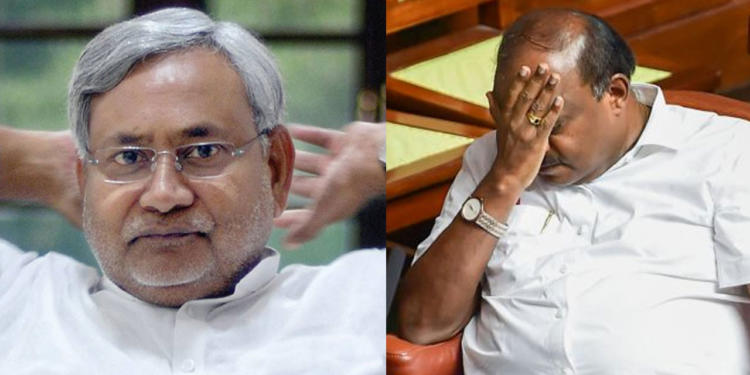After several days of political drama, the Congress-JD(S) coalition government which had come to power last year has finally fallen. Kumaraswamy lost the trust vote 105-99 in favor of the BJP. Ever since, the reports of Congress and JD(S) MLAs tendering their resignations surfaced, it had become clear that the Karnataka government was not going to survive for very long. The coalition government had fallen into a political crisis after reports of 14 MLAs tendering their resignations had come up. It had become clear that once these resignations were accepted, the coalition government would lose its majority.
Karnataka had presented an interesting situation following the assembly elections in the state with a post-poll alliance of JD(S) and the Congress preventing the more popular BJP with a maximum number of seats(104) from forming the government. JD(S) with the least number of seats(37), riding on Congress‘ desperation, was successful in grabbing the Chief Minister’s post despite Congress being the major contributor to the post-poll coalition with 78 seats.
This post-poll coalition was seen by many being contrary to people’s mandate as the Congress and the JD(S) had fought election opposing each other ferociously, however, later on, giving in to political greed had forged this alliance of convenience. Nonetheless this alliance with no ideological basis, after another indication people’s opposition in the 2019 general election finally met its fate.
These developments in Karnataka also have striking similarities with the sequence of events that unfolded in Bihar involving the trio of BJP, JD(U) and the RJD. Nitish Kumar’s JD(U) which walked out of the 17 year old alliance with the BJP just about an year before the 2014 polls citing ‘basic principles’ had only managed to win on 2 PCs as compared to the 20 PCs in the 2009 general elections as the trilateral fight between BJP-JD(U)-RJD was evidently defined by a surge of pro-Modi sentiment in the electorate; with BJP led NDA winning on 31 out of the total 40 PCs in the state.
The 2014 general elections was surely a wakeup call for JD(U) and RJD who were looking at the Bihar state assembly elections in 2015 just one year down the road from the 2014 polls. After the JD(U)’s plan to fight independently failed to materialize, JD(U) was surely desperate to reach out to other parties in order to provide credible resistance to the BJP. Naturally, RJD emerged as the best bet for JD(U). Facing an existential crisis of its own, RJD accepted arch-rivals JD(U) with open arms into an alliance for the 2015 assembly elections. Propelled by the caste calculations and fringe support from Congress the RJD-JD(U) Mahagathbandhan was successful in crossing the majority mark.
The alliance in Bihar captured a total of 178 ACs, with RJD appearing as the largest party in the alliance with a total of 80 MLAs followed by JD(U) (71) and the Congress (27). However, what is interesting to note is that despite getting a higher number of seats, RJD conceded the CM’s post to Nitish Kumar. But, cracks in the alliance were visible from day one over power-sharing issues, for which, not much late in 2017 looking ahead at an imminent pro-Modi wave for the second time, JD(U) dumped the alliance with RJD and come back to the NDA fold and formed the government. The support for which was substantiated with the Lok Sabha mandate this year in May with NDA emerging victorious on 39 out of the 40 PCs in Bihar.
In both the cases of Karnataka and Bihar as the winds of people’s support changed and further solidified, alliances of convenience and political greed failed miserably. The results of 2019 general elections have also brought several other states to focus where parties are running the governments on hair-thin majorities like in Madhya Pradesh, however, after the indication of change of winds in the Lok Sabha, these state governments are sure to face troubled waters in times to come.































